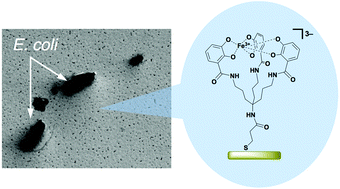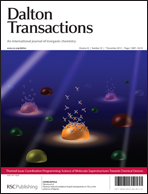A catecholate-type artificial siderophore with a terminal-NH2 group (1) and its Fe3+ complex (2) were prepared. Siderophore 1 was characterized by 1H NMR, FT-IR, and ESI-TOF MS spectroscopy. The corresponding Fe3+ complex 2 was obtained by reaction of 1 with Fe(acac)3. The absorption band at 500 nm (ε = 4670 M−1 cm−1 at pH 7.0) of the electronic absorption spectrum of 2 is assignable as the LMCT (Ocatecholate → Fe3+) absorption band. This band indicates the formation of the Fe3+ complex of 1. The biological activity of 2 with respect to Escherichia coli was clearly confirmed by observing that it permeates into the cell membrane. The self-assembled monolayer of 2 on an Au substrate, 2/Au, was prepared and its preparation was confirmed by FT-IR reflection–absorption spectroscopy (IR-RAS) and cyclic voltammetry (CV). Furthermore, a quartz crystal microbalance (QCM) chip modified with 2 effectively adsorbed E. coli. M. flavescens, an organism which is incapable of synthesizing siderophores and must therefore use exogenous hydroxamate-type siderophores for growth, did not adsorb on 2/Au. In contrast, E. coli did not adsorb on the hydroxamate-type artificial siderophore–Fe3+ complex (3)-modified Au substrate, 3/Au. These results provide preliminary evidence that microbes recognized Fe3+ ion-bound siderophores on the surface. The detection limit of 2/Au was ∼104 CFU mL−1.

You have access to this article
 Please wait while we load your content...
Something went wrong. Try again?
Please wait while we load your content...
Something went wrong. Try again?


 Please wait while we load your content...
Please wait while we load your content...